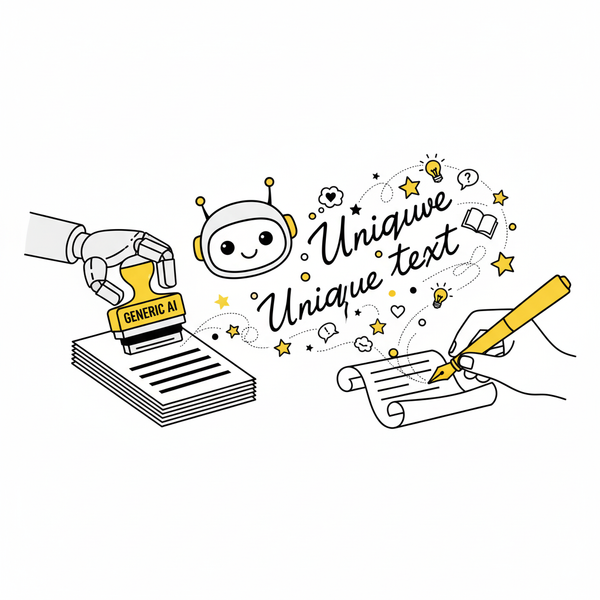How I Built an AI Writing Platform That Doesn't Sound Like AI
This is the story of how I built five features that changed everything, and how I learned that solving AI writing problems means thinking like both a storyteller and a technologist.

I spent months generating prose with AI tools, and every time I hit "generate," I got the same thing back: content that was technically correct, grammatically perfect, and unmistakably AI-written. The prose had that telltale smoothness, those perfect metaphors that land too cleanly, that emotional hand-holding that screamed "optimized by machine."
It was frustrating. I wanted AI to amplify my writing, not replace it with generic output. So I started building something different.
This is the story of how I built five features that changed everything, and how I learned that solving AI writing problems means thinking like both a storyteller and a technologist.
The Problem That Started Everything
I was working on a novel with multiple characters, each with distinct voices. I'd generate dialogue, and the AI would produce perfectly constructed sentences that sounded nothing like my characters. Sarah, a technical expert, would suddenly use flowery metaphors. Marcus, the street-smart detective, would speak like a philosophy professor.
The AI didn't understand my story's world. It didn't know who my characters were, how they spoke, or what my writing voice sounded like.
That's when I realized: AI writing tools treat every generation as an isolated event. They don't maintain context. They don't learn your voice. They don't understand your story.
I needed to build something that did.
Writing Style + Mixer: Breaking Down the Invisible
The first breakthrough came from a simple question: What actually makes a writing style?
I started analyzing prose from different authors. Hemingway's minimalist style vs. Pynchon's maximalist complexity. Faulkner's dense prose vs. Chandler's hard-boiled directness. What were the actual differences?
After analyzing hundreds of samples, I identified 30 distinct style elements across 6 categories:
Core Voice (6 elements): Technical influence, emotional directness, sentence complexity, metaphor density, cynicism/hope balance, pacing
Structure (6 elements): Paragraph length, dialogue ratio, time linearity, action-heavy openings, fragmentation, repetition effects
Description (6 elements): Visual emphasis, physical detail level, setting detail, interiority access, tactile/auditory emphasis
Voice & Tone (6 elements): Narrator presence, humor level, profanity level, vocabulary register, body awareness, temperature/texture details
Special Effects (3 elements): Time dilation, technical accuracy, olfactory emphasis
Thematic (2 elements): Ambiguity tolerance, power dynamics visibility
Each element could be measured from 0-100%. But the real insight came from thinking about how writers actually work: sometimes you want to match an author's voice, sometimes you want to analyze your own writing, and sometimes you want to blend styles.
So I built three creation methods:
- Manual Configuration: Fine-tune every element yourself. This is perfect for writers who know exactly what they want.
- Text Analysis: Upload sample text and let the AI analyze the style automatically. This is perfect for matching existing voices.
- Style Mixer: Combine existing styles with weighted blending. This is perfect for creating hybrid voices.
The Style Mixer was the interesting part. I realized that when writers say "I want 70% Hemingway, 30% Faulkner," they mean it literally. So I built an algorithm that calculates weighted averages across all 30 elements. Blend two styles, and you get a new style profile that combines their characteristics seamlessly.
The technical challenge was ensuring the AI actually respected these profiles. That meant rebuilding the prompt system from scratch. Instead of vague style hints, I now pass complete 30-element style profiles directly into the AI prompt, with explicit instructions for each element.
The result? Styles that actually work. Generate a chapter with your "Dark Noir" style, and every sentence respects that profile. Switch to "Epic Fantasy," and the voice shifts completely. The AI isn't guessing. It has precise instructions.
Generate PRO: Learning to Love Imperfection
Even with perfect style profiles, I kept hitting the same wall: the AI generated prose that was technically correct but felt robotic.
I started collecting examples of "AI-slop," those telltale patterns that scream "machine-written." "Neon-soaked" descriptions. "Data rivers" metaphors. "Cathedral of code" clichés. Perfect metaphors that land too cleanly. Emotional hand-holding. That smoothness that comes from over-optimization.
The problem wasn't the AI models themselves. It was how they were being prompted. Most AI tools optimize for clarity and correctness. Ironically, that makes the output sound more AI-generated.
So I started building an anti-AI-slop system. I maintained a database of AI-sounding patterns, organized by severity. Critical patterns like "neon-soaked" and "cathedral of code." Error patterns like "realized/understood that" (telling vs showing). Warning patterns like overused dialogue transitions.
But pattern detection wasn't enough. I needed to teach the AI how humans actually write.
That's when I discovered professional fiction editing techniques. There's a whole field of humanization, techniques editors use to make prose feel more authentically human. I studied nine core techniques:
- Micro Texture and Sensory Asymmetry: Replace generic descriptions with unexpected, character-specific details
- Dialogue Disruption: Break perfect call-and-response with interruptions and non-sequiturs
- Emotional Ambush: Let emotions arrive unannounced, mid-thought
- Specificity Over Placeholder: Use proper nouns, brand names, model numbers
- Thought Entanglement: Allow contradictory thoughts, incomplete thoughts
- Remove Safety Rails: Cut hedging language and emotional hand-holding
- Rhythm Disruption: Vary sentence length violently and without pattern
- Permission to Be Ugly: Allow irrelevant details, half-formed reactions, petty thoughts
- Strategic Subtraction: Remove over-explanation and literary-sounding phrases
These weren't just prompt additions. They were protocols. I built a humanlikeness engine that generates specific instructions based on intensity level (subtle, moderate, strong, extreme). At "extreme" intensity, the AI is literally instructed to add strategic imperfections: slightly awkward phrasings, metaphors that don't quite land, abrupt transitions.
The most interesting part was the self-review system. I realized that human writers review their own work, so why shouldn't AI? I built a system where the AI generates content, then reviews it using focus areas (dialogue, emotion, voice, pacing, description). The AI identifies issues and applies targeted corrections.
It sounds counterintuitive: use AI to detect AI patterns, then use AI to fix them. But it works. The self-review process catches issues that initial generation misses.
The technical implementation was complex. I built multiple layers:
- Pattern detection with regex matching and severity scoring
- Humanlikeness protocol generation based on intensity
- Self-review system with configurable focus areas
- Metaphor generation algorithm with degradation/elevation techniques
All of this gets compiled into a single prompt that the AI receives. The result? Prose that reads like it was written by a human, including strategic imperfections and natural awkwardness.
Improve with Ash: The Agent That Understands Context
I kept running into the same problem: I'd write something that was almost right, but needed tweaking. The dialogue needed sharpening. The description needed more specificity. The pacing felt off.
Generic AI editors could help, but they didn't understand my story. They didn't know my characters' voices. They didn't know my locations. They didn't know my lore.
I needed an editor that understood context.
So I built "Ash," an AI agent specifically for text improvement. But Ash isn't just a better AI editor. Ash understands your entire story.
The key insight was context aggregation. When you select text and tell Ash what to improve, Ash pulls context from your entire story:
- Character profiles, including dialogue styles, speech patterns, vocabulary levels, accents
- Location descriptions and atmosphere details
- Lore and world-building elements
- Your selected writing style profile
- Previous chapters for consistency
All of this context gets included in the improvement prompt. If you say "make this dialogue sound more like Sarah," Ash knows exactly how Sarah speaks because it has her complete profile.
The technical challenge was building the context aggregation system. I needed to fetch character data, location data, lore data, and style data, then compile it into a coherent prompt. I built a context aggregator that pulls from multiple sources, caches results for performance, and formats everything for the AI.
But the real innovation was the special instructions system. Beyond basic improvement instructions, you can provide nuanced guidance:
- "Keep the cynical tone but make it more subtle"
- "Match the rhythm of the previous paragraph"
- "Reference the item description from the Items folder"
Ash uses Claude Sonnet 4.5 for high-quality improvements, but the secret is the context. Generic editors improve grammar and clarity. Ash improves text while maintaining consistency and voice.
I integrated Ash directly into the editor. Select text, click "Improve with Ash," provide instructions, and the text gets replaced immediately. One-click revert if you're not happy.
The result? An editor that doesn't just fix grammar. It improves text while understanding your story's world.
Story Element References: Teaching AI About Your World
The biggest frustration was consistency. I'd generate dialogue for Character A, and the AI would forget their speech patterns. I'd describe Location B, and the AI would contradict established details.
The problem was obvious: the AI didn't have context about my story elements. I needed to give it that context.
So I built a reference system. During AI generation, you can select any story element as a reference: characters, locations, lore, organizations, items, events. The system pulls comprehensive data about each element and includes it in the AI prompt.
For characters, that means:
- Full character profile and background
- Dialogue style (formal, casual, technical, etc.)
- Speech patterns (sentence length, vocabulary complexity)
- Vocabulary level and register
- Accent and dialect information
- Personality traits and quirks
For locations:
- Full location description
- Atmosphere and mood details
- Physical layout and sensory details
- Historical or contextual information
The technical challenge was building the context aggregation system. I needed to:
- Fetch data from multiple sources (story_nodes table with different node types)
- Format character data differently from location data
- Handle dialogue styles, speech patterns, vocabulary—structured data beyond just content
- Cache results for performance (5-minute TTL)
- Compile everything into a coherent prompt section
I built a ContextAggregator class that handles all of this. It knows what data to pull based on node type, formats it appropriately, and includes it in the prompt. The system is smart enough to pull character dialogue data differently from location descriptions.
The result? When you reference Character A during generation, the AI knows exactly how Character A speaks. When you reference Location B, the AI knows its atmosphere and details. The AI isn't generating generic content. It's generating content that matches your established world.
But references work with other features too. They inform voice while maintaining style consistency. Anti-AI-slop detection applies while respecting character voices. Everything connects.
The breakthrough moment was realizing that story references aren't just metadata. They're the difference between generic AI output and content that feels like part of your actual story.
File System Structure: Organizing the Chaos
I was working on a complex story with multiple characters, locations, lore entries, organizations, items, and events. Keeping track of everything was overwhelming. I'd spend more time searching for information than writing.
Most writing tools treat everything as "files" or "documents." They force you to create your own organizational system. But storytelling has natural structure: characters belong together, locations belong together, lore belongs together.
So I built a hierarchical file system designed specifically for storytelling. Each story gets a standardized structure:
- Characters: Character profiles, dialogue styles, relationships
- Locations: Settings, atmosphere descriptions, geographical details
- Lore: World-building, history, rules of your universe
- Organizations: Groups, hierarchies, political structures
- Items: Objects, weapons, tools, artifacts
- Events: Key happenings, timelines, consequences
- Chapters: Your actual story content
The technical implementation was straightforward: story nodes with a node_type field, organized by folder structure. But the real value came from integration with other features.
When you're generating content, you can select any file as a reference. The system knows what type each file is and pulls the appropriate context automatically. Characters pull dialogue data. Locations pull atmosphere data. Everything connects.
I built drag-and-drop reorganization, search and filter capabilities, word count tracking, and visual folder expansion/collapse. But the killer feature is reference integration. The file system isn't just organization. It's the foundation for context-aware AI generation.
The breakthrough was realizing that organization and AI generation should work together. The file system isn't separate from AI features. It enables them.
What I Learned: Storytelling Meets Technology
Building these features taught me something important: solving AI writing problems requires thinking like both a storyteller and a technologist.
As a storyteller, I understood the problems:
- Writers need control over voice
- Prose needs to feel authentically human
- Context matters for consistency
- Organization prevents chaos
As a technologist, I built solutions:
- Style profiles with 30 granular elements
- Anti-AI-slop detection with pattern matching
- Context aggregation systems
- Hierarchical file structures
But the real breakthroughs came from the intersection:
- Understanding writing style well enough to break it into 30 measurable elements
- Studying professional fiction editing to build humanization protocols
- Building context systems that understand story structure
- Creating organization that enables AI features
These aren't just technical features. They're solutions to real storytelling problems, built by someone who understands both domains.
The Result: AI That Amplifies Instead of Replaces
AI Story Hub isn't just another AI writing assistant. It's a platform where AI amplifies your creativity instead of replacing it.
These five features work together:
- Writing Styles ensure AI output matches your voice
- Generate PRO makes that output sound authentically human
- Improve with Ash refines specific sections with full story context
- Story References keep everything consistent with your world
- File System keeps your complex stories organized and accessible
The result? A writing platform where you maintain full control over voice, style, and story while leveraging AI's speed and capability.
Building it taught me that the best technology solutions come from deeply understanding the problems they solve. I wasn't just building features. I was solving frustrations I'd experienced as a writer, using skills I'd developed as a technologist.
That intersection—storytelling and technology—is where the magic happens.




